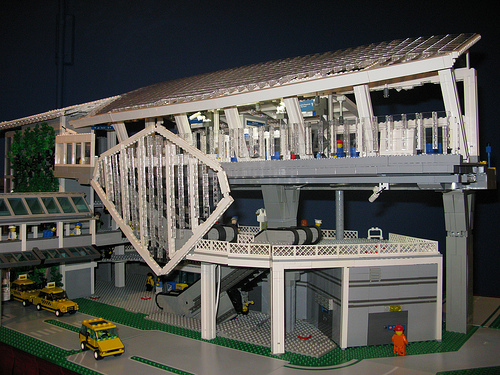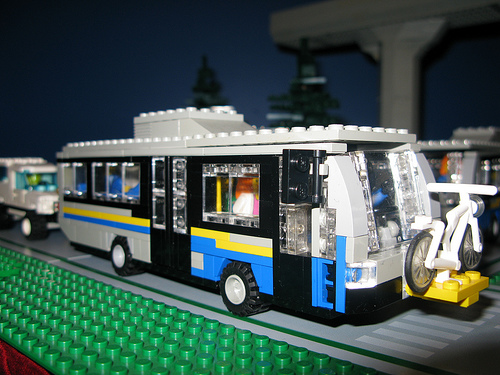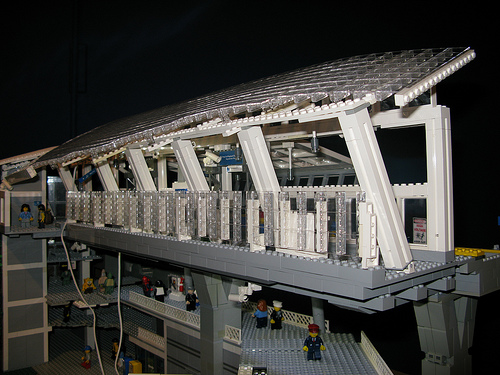Canada Line stations… in LEGO!
Canada Line stations… in LEGO!

Check out Science World’s LEGO exhibition to see two Canada Line stations modeled in the famous building blocks — YVR-Airport and King Edward Stations!
These station models debuted last Saturday, Mar. 7 to expand the existing exhibition, which originally launched in January.
I’m waiting for more on the King Edward replica, but right now I can share lots of background on the YVR model.
The Vancouver LEGO Club built YVR Station especially for the exhibition, which is called Wheels, Wings and Waves—a LEGO® World of Transportation.
The model includes working escalators, lighting and, a moving Canada Line train pulling into the station—all of which can be activated with a button by Science World visitors. There’s also reproductions of two Translink NovaBus LFS buses.
Here’s a video of the escalator in motion (again, courtesy of Tim Tosino):
The club was asked to model YVR station by SNC-Lavalin, a sponsor of the LEGO exhibit and the firm leading the construction of the Canada Line.
Seven members built the station: Shane Weckstrom (the lead coordinator), Allan Corbeil, Andrew Robertson, Dave DeGobbi, David Gagnon, Paul Nagelkerke, and Tim Tosino.
Tim explained that the members contributed over 7000 of their own LEGO pieces and over 100 build hours to create the model, between January and March 2009.

SNC-Lavalin helped them out with blueprints and drawings, and took some of the members on a tour of the station.
The members then divided the building up into pieces they could construct separately — for instance, one person did the moving escalator and another did the guideway.
The station in its full form was only ever really assembled once before it was brought to Science World for a “test build.”

What was the hardest part? The roof was particularly hard, said Tim, as the station’s roof curves, and it’s particularly difficult to do curved shapes in LEGO.
The escalator also posed a challenge, requiring a hole to be cut in the display table— the figures on the escalators are attached to LEGO tread, and couldn’t clear the table on the return path without coming off.
Tim also said they tried to incorporate as much detail of the station as they could, although some sacrifices had to be made. For example, the real Novabus LFS holds over 70 people, but in the LEGO model, Tim was only able to provide 8 seats :)
Adjustments were also made to the station – the middle floors were condensed a bit and most attention to detail was done on the platform level.
If you’d like to go down and see the models, Wheels, Wings, and Waves will run until May 4 at Science World. The exhibit features many more Lego replicas of local transportation, including an enormous B.C. Ferry!
And check out more photos of the exhibit at Tim’s Flickr feed. Thanks again for sharing with us, Tim!






The bike on the bike rack of the Nova Bus is what sold me there. Awesome.
Any chance Tim might be interested in posting the designs once the exhibit’s over? It’d be fun to make your own Lego bus or train. :D
Reverse Engineering is fun. Much of the bus was reverse engineered from this design http://www.flickr.com/photos/madphysicist/2533550720/in/photostream/ (Many Thanks to Raplh and his bus)
There’s some speciality parts you might have to order but you can order the windows from Lego.com. Feel free to ask me on flickr about design and pieces as well.
Thank you, everybody, for the cool stuff that you do. I appreciate all the neat stuff that goes on.
Thank you, Lego guys.
Thank you, sponsors.
Thank you, Jhenifer, for finding these great stories.
I love reading the Buzzer blog.
Thanks for posting this, Jhenifer! I never would have found out about this exhibit otherwise. I am definitely going to see this.
I used to try and make Lego buses and trains when I was a kid. The beauty of Lego is that it makes you improvise and learn how to work with what you got — you can make excellent exterior recreations with Legos, but the inside of your creations will never be realistic or to scale. (I had the same problem with trying to fit the “proper” number of seats in my creations as well.)
It’s amazing what some people can do with a little imagination and tenacity, though, as those models of Vancouver structures look too realistic to be Legos. When I was a kid, almost all Legos were cube or rectangle shaped. We didn’t have curvy or sloped pieces. Certainly not the kinds of pieces that could do that wicked roof!
I must see the other transportation models too, of course, including that ferry.
If I wore a hat, I’d tip it to the folks in the Lego club.
hey the exhibit is going to be in may! thats when my b-day is! maybe ill drop buy to check it out!
I LOVE TRANSLINK BUSES & SKYTRAINS!
I missed it, sadly… But, i’m moving back to Vancouver soon and i’m joining the LEGO club, so we might do it again!
The video and pictures are unhelpful
do a better video and some better pictures